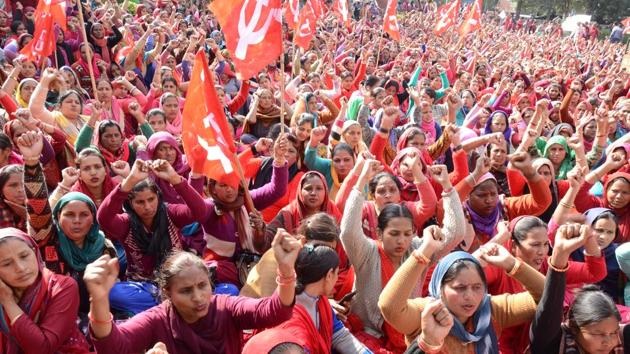In a ruling that will have an impact across the country, the Gujarat high court has said anganwadi workers and helpers in the state are entitled to be absorbed as permanent employees with all the benefits of government employees.
Justice Nikhil S Kareil has asked the Gujarat government to prepare plans to induct these women as permanent government employees.
An estimated 2.4 million all-women anganwadi workers and helpers in India, 100,000 in Gujarat, are officially classified as ‘volunteers’ who get an ‘honorarium’ and none of the benefits of maternity leave, pension and other benefits of government employees.

They perform a vital function in meeting and maintaining India’s nutritional and health status for pregnant and lactating women as well as children under six. For this, the court observed: “They are paid a meagre amount per month under the guise of honorarium.” He has asked the state government to treat them as permanent civil employees.
An integral part of the Integrated Child Development Scheme, anganwadi workers and helpers provide nutritional support, health education and early childhood education at anganwadi (literally, courtyard) centers. Their remuneration varies from state to state, but on average, an anganwadi worker earns about ₹10,000 and a helper around ₹5,500.
Full workload
“Nobody really aspires to be an anganwadi worker because the work is so much and the pay so little,” says Poonam who uses just one name and began working in an anganwadi in Delhi in 2013. “We do it because of unemployment and a lack of jobs. There are no opportunities so we take what we can.”
In Delhi, an anganwadi worker makes ₹12,720 a month, which is less than the minimum wage mandated for unskilled workers in the capital city. Poonam’s helper who has a master’s degree, washes utensils and sweeps the floor for ₹6,810.
Over time, with new laws such as the Right to Education in 2009 and the Food Security in 2013, workload has expanded and anganwadi workers must provide supplementary nutrition to children by cooking and serving them healthy meals and also to pregnant and lactating mothers. They ensure their immunisation is up-to-date. They must maintain records and growth and height charts. Are the women aware of various government schemes? In states like Gujarat they conduct pre-primary activities for children under six.

“We have to organise godh bharai ceremonies (baby showers) for which we gift the mother-to-be bangles, bindis and the like. We have to go to the market to buy them,” Poonam tells me while trying to explain the real workload. It is her job, she says, to educate women under her charge about immunisation and disease. During Covid, they were tasked with distributing dry rations from house to house.
In 2022, Poonam joined the Delhi State Anganwadi and Helper union who called for a strike unless their demand for better wages and recognition was met. The government invoked the Essential Services and Maintenance Act (ESMA) and Poonam was only of the 884 women whose services were terminated. The women went to court and that case is still pending.

The demand for regularisation and better wages cuts across India. In Guwahati, anganwadi workers held demonstrations in November. In Tamil Nadu, workers and helpers asked for increased salaries and also criticised the central government’s budget cuts to anganwadi allocations. In Punjab, the women held protests in October. And in Maharashtra, 20,000 women organised a prolonged sit-in at Azad Maidan in December 2023.
Miles to go
The anganwadi workers have had other court wins. In May 2022 in Gujarat itself, five Adivasi workers who had retired after 21 to 31 years of service went to court demanding gratuity. They won. The government then went into appeal. Then the women won in the Supreme Court.
The two-judge bench said all anganwadi workers and helpers are entitled to gratuity. Justices Ajay Rastogi and Abhay S Oka said the women perform “all pervasive duties” for which they are paid “very meagre renumeration and paltry benefits”.
The government says if the women are regularised and become full-time employees, it will end up with a huge wage bill.
Left unsaid is the assumption that women’s work is worth very little, even for the government. Many anganwadi workers come from marginalised backgrounds and they do this work because every small amount makes a difference to the household budget.
The Gujarat high court decision is welcome, Priyambada Sharma, a Delhi-based activist associated with the anganwadi workers’ fight for recognition, told me. But, she warned, there’s a long road ahead before the government grants the women the status of government employee. “This is a long pending demand and the court decision is a good one, but we fear the government will not implement it.”
The following article is an excerpt from this week’s HT Mind the Gap. Subscribe here.







